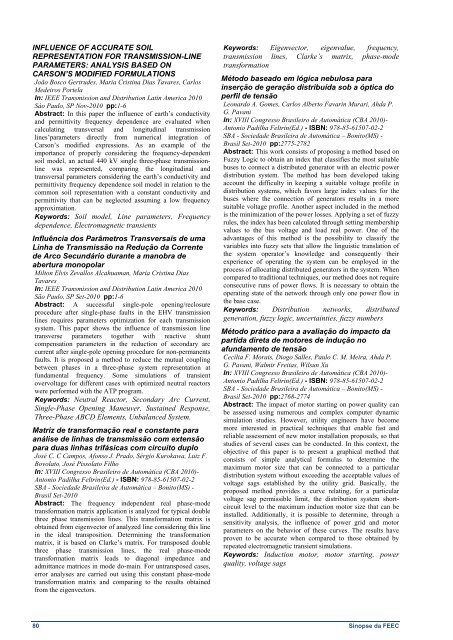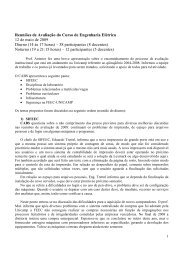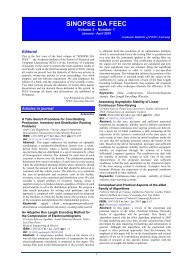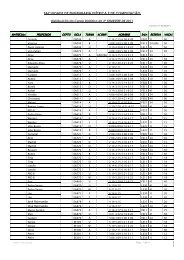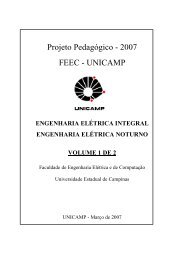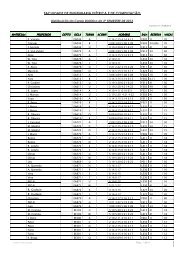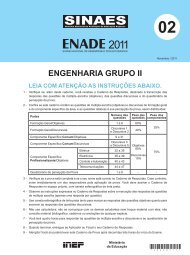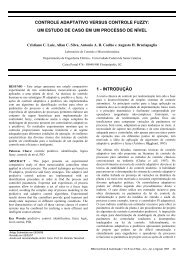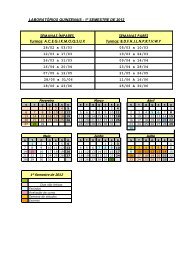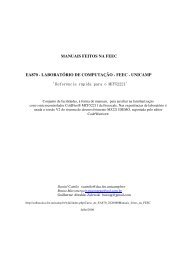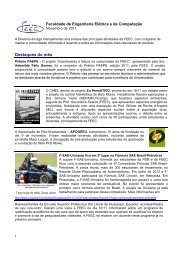sinopseV3n3.pdf - FEEC - Unicamp
sinopseV3n3.pdf - FEEC - Unicamp
sinopseV3n3.pdf - FEEC - Unicamp
Create successful ePaper yourself
Turn your PDF publications into a flip-book with our unique Google optimized e-Paper software.
INFLUENCE OF ACCURATE SOIL<br />
REPRESENTATION FOR TRANSMISSION-LINE<br />
PARAMETERS: ANALYSIS BASED ON<br />
CARSON’S MODIFIED FORMULATIONS<br />
João Bosco Gertrudes, Maria Cristina Dias Tavares, Carlos<br />
Medeiros Portela<br />
In: IEEE Transmission and Distribution Latin America 2010<br />
Sáo Paulo, SP Nov-2010 pp:1-6<br />
Abstract: In this paper the influence of earth’s conductivity<br />
and permittivity frequency dependence are evaluated when<br />
calculating transversal and longitudinal transmission<br />
lines’parameters directly from numerical integration of<br />
Carson’s modified expressions. As an example of the<br />
importance of properly considering the frequency-dependent<br />
soil model, an actual 440 kV single three-phase transmissionline<br />
was represented, comparing the longitudinal and<br />
transversal parameters considering the earth’s conductivity and<br />
permittivity frequency dependence soil model in relation to the<br />
common soil representation with a constant conductivity and<br />
permittivity that can be neglected assuming a low frequency<br />
approximation.<br />
Keywords: Soil model, Line parameters, Frequency<br />
dependence, Electromagnetic transients<br />
Influência dos Parâmetros Transversais de uma<br />
Linha de Transmissão na Redução da Corrente<br />
de Arco Secundário durante a manobra de<br />
abertura monopolar<br />
Milton Elvis Zevallos Alcahuaman, Maria Cristina Dias<br />
Tavares<br />
In: IEEE Transmission and Distribution Latin America 2010<br />
São Paulo, SP Set-2010 pp:1-6<br />
Abstract: A successful single-pole opening/reclosure<br />
procedure after single-phase faults in the EHV transmission<br />
lines requires parameters optimization for each transmission<br />
system. This paper shows the influence of transmission line<br />
transverse parameters together with reactive shunt<br />
compensation parameters in the reduction of secondary arc<br />
current after single-pole opening procedure for non-permanents<br />
faults. It is proposed a method to reduce the mutual coupling<br />
between phases in a three-phase system representation at<br />
fundamental frequency. Some simulations of transient<br />
overvoltage for different cases with optimized neutral reactors<br />
were performed with the ATP program.<br />
Keywords: Neutral Reactor, Secondary Arc Current,<br />
Single-Phase Opening Maneuver, Sustained Response,<br />
Three-Phase ABCD Elements, Unbalanced System.<br />
Matriz de transformação real e constante para<br />
análise de linhas de transmissão com extensão<br />
para duas linhas trifásicas com circuito duplo<br />
José C. C Campos, Afonso J. Prado, Sérgio Kurokawa, Luiz F.<br />
Bovolato, José Pissolato Filho<br />
In: XVIII Congresso Brasileiro de Automática (CBA 2010)-<br />
Antonio Padilha Feltrin(Ed.) - ISBN: 978-85-61507-02-2<br />
SBA - Sociedade Brasileira de Automática – Bonito(MS) -<br />
Brasil Set-2010<br />
Abstract: The frequency independent real phase-mode<br />
transformation matrix application is analyzed for typical double<br />
three phase transmission lines. This transformation matrix is<br />
obtained from eigenvector of analyzed line considering this line<br />
in the ideal transposition. Determining the transformation<br />
matrix, it is based on Clarke’s matrix. For transposed double<br />
three phase transmission lines, the real phase-mode<br />
transformation matrix leads to diagonal impedance and<br />
admittance matrices in mode do-main. For untransposed cases,<br />
error analyses are carried out using this constant phase-mode<br />
transformation matrix and comparing to the results obtained<br />
from the eigenvectors.<br />
Keywords: Eigenvector, eigenvalue, frequency,<br />
transmission lines, Clarke’s matrix, phase-mode<br />
transformation<br />
Método baseado em lógica nebulosa para<br />
inserção de geração distribuída sob a óptica do<br />
perfil de tensão<br />
Leonardo A. Gomes, Carlos Alberto Favarin Murari, Ahda P.<br />
G. Pavani<br />
In: XVIII Congresso Brasileiro de Automática (CBA 2010)-<br />
Antonio Padilha Feltrin(Ed.) - ISBN: 978-85-61507-02-2<br />
SBA - Sociedade Brasileira de Automática – Bonito(MS) -<br />
Brasil Set-2010 pp:2775-2782<br />
Abstract: This work consists of proposing a method based on<br />
Fuzzy Logic to obtain an index that classifies the most suitable<br />
buses to connect a distributed generator with an electric power<br />
distribution system. The method has been developed taking<br />
account the difficulty in keeping a suitable voltage profile in<br />
distribution systems, which favors large index values for the<br />
buses where the connection of generators results in a more<br />
suitable voltage profile. Another aspect included in the method<br />
is the minimization of the power losses. Applying a set of fuzzy<br />
rules, the index has been calculated through setting membership<br />
values to the bus voltage and load real power. One of the<br />
advantages of this method is the possibility to classify the<br />
variables into fuzzy sets that allow the linguistic translation of<br />
the system operator’s knowledge and consequently their<br />
experience of operating the system can be employed in the<br />
process of allocating distributed generators in the system. When<br />
compared to traditional techniques, our method does not require<br />
consecutive runs of power flows. It is necessary to obtain the<br />
operating state of the network through only one power flow in<br />
the base case.<br />
Keywords: Distribution networks, distributed<br />
generation, fuzzy logic, uncertainties, fuzzy numbers<br />
Método prático para a avaliação do impacto da<br />
partida direta de motores de indução no<br />
afundamento de tensão<br />
Cecília F. Morais, Diogo Salles, Paulo C. M. Meira, Ahda P.<br />
G. Pavani, Walmir Freitas, Wilsun Xu<br />
In: XVIII Congresso Brasileiro de Automática (CBA 2010)-<br />
Antonio Padilha Feltrin(Ed.) - ISBN: 978-85-61507-02-2<br />
SBA - Sociedade Brasileira de Automática – Bonito(MS) -<br />
Brasil Set-2010 pp:2768-2774<br />
Abstract: The impact of motor starting on power quality can<br />
be assessed using numerous and complex computer dynamic<br />
simulation studies. However, utility engineers have become<br />
more interested in practical techniques that enable fast and<br />
reliable assessment of new motor installation proposals, so that<br />
studies of several cases can be conducted. In this context, the<br />
objective of this paper is to present a graphical method that<br />
consists of simple analytical formulas to determine the<br />
maximum motor size that can be connected to a particular<br />
distribution system without exceeding the acceptable values of<br />
voltage sags established by the utility grid. Basically, the<br />
proposed method provides a curve relating, for a particular<br />
voltage sag permissible limit, the distribution system shortcircuit<br />
level to the maximum induction motor size that can be<br />
installed. Additionally, it is possible to determine, through a<br />
sensitivity analysis, the influence of power grid and motor<br />
parameters on the behavior of these curves. The results have<br />
proven to be accurate when compared to those obtained by<br />
repeated electromagnetic transient simulations.<br />
Keywords: Induction motor, motor starting, power<br />
quality, voltage sags<br />
80 Sinopse da <strong>FEEC</strong>


